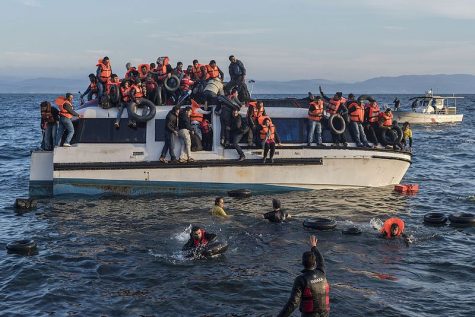Trouble in Syria: The Relentless Refugee Crisis
Ever since the Syrian Civil War began in 2011, over 4.5 million Syrians have fled their home country in hopes of safety or resettlement. However, finding refuge may prove difficult due to the restrictions binding the immigration system formed by Europe and the U.S. The war between the Islamic State (IS), President Bashar al Assad’s regime, and other rebel groups has caught innocent civilians in the crossfire, as the death toll rose to a staggering 470,000 deaths.

According to BBC News, the conflict began when a group of teenagers were arrested and tortured for spraying political graffiti on a school wall. This action sparked a protest, but Assad’s security forces opened fire on the demonstrators. Nevertheless, protestors continued resisting, demanding Assad’s resignation, but with more protests, more of Assad’s forces enforced security. Many Syrians armed themselves, at first to defend themselves, but later, to drive Assad’s forces out of their area. This quickly escalated into civil war, creating many major rebel groups such as the Free Syrian Army (FSA), the Al-Qaeda fighters, the Kurdish fighters, and, the most notorious, IS.
Recently, the war in Syria has come to a standstill. After ten months of discussions without solutions, the U.S. and Russia have finally found a way to tackle the Syrian war. The U.S. and Russia have created a truce to call for ceasefire in the in the hopes of taking down common enemies: Al-Queda forces and IS. Although the U.S. and Russia support opposing armies; Russia backing Assad and the U.S. assisting the rebel forces, both powers agree that the number of civilian deaths must decrease. Secretary of State John Kerry states: “If this holds, then we will see a significant reduction in violence across Syria.” By declaring a ceasefire between Assad and the rebels, both countries can call for air strikes against the main terrorist groups.
The refugees who escaped the war are in a state of peril and poverty. During a Ted Talk, Alexander Betts, a social scientist and director of the Refugee Studies Center of the University of Oxford, discusses three basic options: “We present refugees with an almost impossible choice between three options: encampment, urban destitution, or a dangerous journey.” These options are flawed with poor living conditions, and the third option is also fraught with danger. There are only two ways of traveling to Europe: by land or by sea. Travelling by land is much safer in comparison to the sea, in which case it is easy to capsize in the flimsy rubber dinghies or small wooden boats. The International Organization of Migration (IOM) has reported that over 3,770 migrants died attempting to cross the Aegean Sea.
At the beginning of the year, President Obama pledged to take 10,000 refugees into the U.S. by the end of the year. Although 10,000 refugees is a relatively large number of refugees, the number of accepted Syrian refugees in the Middle East countries makes 10,000 pale in comparison. For example, Lebanon, a neighboring country near Syria, hosts around 1.1 million refugees. Turkey has the highest number of Syrian refugees in their country: 2.5 million. It is not only the U.S. that is not accepting many refugees. According to BBC news, over a million asylum claims have been staked in Europe, but only a quarter of a million claims were actually accepted.
Even though Europe and the U.S. are accepting a very minimal number of refugees, there are plenty of valid reasons behind it. One reason is that the Syrian refugees need to be thoroughly screened in order to gain access to the European countries. However, due to the irregular migration flow, and the large number of refugees appearing within the shores of their territory, the screening process is much harder to execute. In addition to this, many countries only accept their desired number of refugees. For the U.S., the screening process is immensely time-consuming. The screening process involves many background and medical checks, interviews, and other steps. All of the steps usually take eighteen to twenty four months.
Tragic incidents over the last couple of years have caused apprehensions of future terror attacks. This fear has manifested itself into a call for tighter regulation of refugees. Following the Paris attacks, North Carolina Governor, Pat McCroy, states: “Because of the very real possibility that one of the terrorists entered France as a refugee, I request that the President and the federal government cease accepting refugees from Syria.” The Syrian refugee crisis is clearly in a dire state, and requires collaboration and efficiency in minimizing the number of deaths and maximizing the safety and welfare of the refugees.





